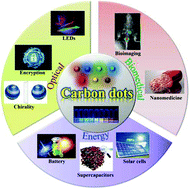Frontiers in carbon dots: design, properties and applications
Abstract
Carbon dots (CDs), which are emerging as a novel class of carbon-based functional nanomaterials, can be fabricated from various carbon-based materials such as graphite, activated carbon, carbon nanotubes and many other organic materials. Recently, researchers have paid attention to emerging CDs and investigated their application prospects in a variety of fields, including optical, energy and biomedical technologies. In this review, we provide an up-to-date account of the design, preparation, fundamentals and applications of functional CDs. We begin with an overview on the synthetic methods of novel CDs, including “bottom-up” and “top-down” approaches, post-synthetic modification and functionalisation, through which the diverse properties of CDs such as optical, dispersibility and biocompatibility properties are introduced. We then showcase the applications of advanced CDs in different fields, including optical applications (data security, sensors, light-emitting diodes, and chiral), energy applications (photocatalysts, solar photovoltaics, supercapacitors, and lithium-ion batteries) and promising biomedical applications (bioimaging and nanomedicine). We discuss the fundamental design ideas of such emerging and unique CDs, introduce their synthetic strategies and emphasise their significant applications. This review is expected to provide significant impetus towards the rapid expansion of this new materials field which is rooted in materials chemistry. The fields covered include physics, chemistry, biology, nanotechnology, energy, polymers, device engineering and other interdisciplinary areas.

- This article is part of the themed collections: Materials Chemistry in Tianjin University and 2019 Materials Chemistry Frontiers Review-type Articles


 Please wait while we load your content...
Please wait while we load your content...